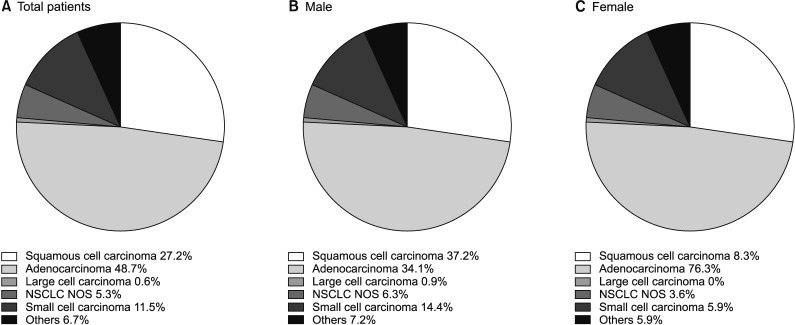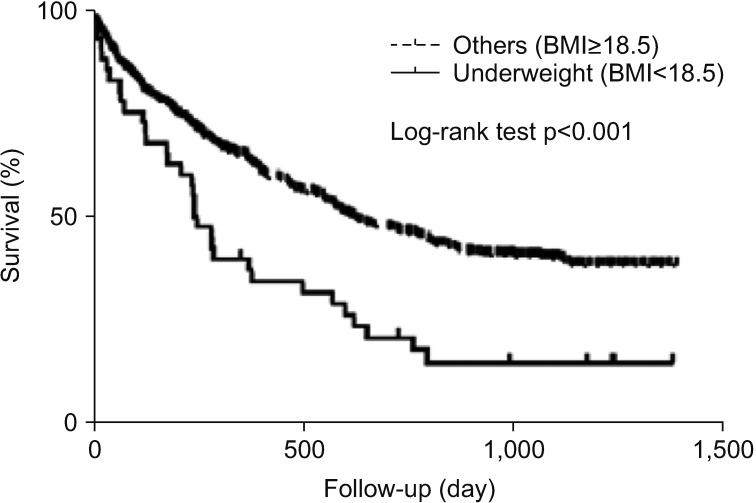Clinical Characteristics and Prognostic Factors of Lung Cancer in Korea: A Pilot Study of Data from the Korean Nationwide Lung Cancer Registry
- Affiliations
-
- 1Department of Pulmonary and Critical Care Medicine, Asan Medical Center, University of Ulsan College of Medicine, Seoul, Korea. ccm9607@gmail.com
- 2Department of Internal Medicine, Catholic University of Daegu School of Medicine, Daegu, Korea.
- 3Department of Thoracic and Cardiovascular Surgery, St. Vincent's Hospital, College of Medicine, The Catholic University of Korea, Suwon, Korea.
- 4Center for Lung Cancer, National Cancer Center, Goyang, Korea.
- 5Division of Pulmonology, Department of Internal Medicine, Chungnam National University, Daejeon, Korea.
- 6Department of Medicine, Samsung Medical Center, Sungkyunkwan University, Seoul, Korea.
- 7Division of Pulmonology, Department of Internal Medicine, The Cancer Research Institute, College of Medicine, The Catholic University of Korea, Seoul, Korea.
- 8Department of Cardiothoracic Surgery, Pusan National University Hospital, Busan, Korea.
- 9Department of Pulmonary Medicine, Chonnam National University Hwasun Hospital, Chonnam National University Medical School, Hwasun, Korea.
- 10Cancer Registration and Statistics Branch, National Cancer Center, Goyang, Korea.
- 11Department of Oncology, Asan Medical Center, University of Ulsan College of Medicine, Seoul, Korea.
- KMID: 2453981
- DOI: http://doi.org/10.4046/trd.2017.0128
Abstract
- BACKGROUND
Lung cancer is a leading cause of morbidity and mortality worldwide, and the incidence continues to rise. Although many prognostic factors have been identified, the clinical characteristics and outcomes in Korean lung cancer patients are not well defined.
METHODS
Of the 23,254 new lung cancer cases registered at the Korea Central Cancer Registry in 2013, total 489 patients from 19 hospitals were abstracted by the Korean Central Cancer Registry. The clinical data retrospectively analyzed, patients were followed up until December 2015.
RESULTS
The median age was 69 years (interquartile range, 60-74 years); 65.4% were male and 62.1% were ever-smokers. Cough was the most common initial symptom (33.5%); 13.1% of patients were asymptomatic. While squamous cell carcinoma was the most common subtype in male patients (37.2%), adenocarcinoma was the most frequent histological type in all patients (48.7%) and females (76.3%). The majority of patients received treatment (76.5%), which included surgery, radiation therapy, and chemotherapy. Older age (hazard ratio [HR], 1.037), lower body mass index (HR, 0.904), ever-smoker (HR, 2.003), small cell lung cancer (HR, 1.627), and distant metastasis (HR, 3.990) were independent predictors of mortality. Patients without symptoms (HR, 0.387) and without treatment (HR, 0.364) were associated with a favorable outcome in multivariate Cox analysis.
CONCLUSION
Lung cancer in Korea occurs predominantly in elderly patients, with adenocarcinoma being the most frequent subtype. The prognosis was poorer in ever-smokers and older, malnourished, and untreated patients with advanced lung cancer.
Keyword
MeSH Terms
Figure
Cited by 6 articles
-
Trends and Updated Statistics of Lung Cancer in Korea
Chan Kwon Park, Seung Joon Kim
Tuberc Respir Dis. 2019;82(2):175-177. doi: 10.4046/trd.2019.0015.The Development of the Korean Lung Cancer Registry (KALC-R)
Young-Chul Kim, Young-Joo Won
Tuberc Respir Dis. 2019;82(2):91-93. doi: 10.4046/trd.2018.0032.Current Status of Immunotherapy for Lung Cancer and Future Perspectives
Ho Cheol Kim, Chang-Min Choi
Tuberc Respir Dis. 2020;83(1):14-19. doi: 10.4046/trd.2019.0039.MicroRNA-374a Expression as a Prognostic Biomarker in Lung Adenocarcinoma
Yeseul Kim, Jongmin Sim, Hyunsung Kim, Seong Sik Bang, Seungyun Jee, Sungeon Park, Kiseok Jang
J Pathol Transl Med. 2019;53(6):354-360. doi: 10.4132/jptm.2019.10.01.Report of the Korean Association of Lung Cancer Registry (KALC-R), 2014
Chang-Min Choi, Ho Cheol Kim, Chi Young Jung, Deog Gon Cho, Jae Hyun Jeon, Jeong Eun Lee, Jin Seok Ahn, Seung Joon Kim, Yeongdae Kim, Yoo-Duk Choi, Yang-Gun Suh, Jung-Eun Kim, Boram Lee, Young-Joo Won, Young-Chul Kim
Cancer Res Treat. 2019;51(4):1400-1410. doi: 10.4143/crt.2018.704.The Real-World Outcome of First Line Atezolizumab in Extensive-Stage Small Cell Lung Cancer: A Multicenter Prospective Cohort Study
Myeong Geun Choi, Yeon Joo Kim, Jae Cheol Lee, Wonjun Ji, In-Jae Oh, Sung Yong Lee, Seong Hoon Yoon, Shin Yup Lee, Jeong Eun Lee, Eun Young Kim, Chang-Min Choi
Cancer Res Treat. 2024;56(2):422-429. doi: 10.4143/crt.2023.913.
Reference
-
1. Siegel RL, Miller KD, Jemal A. Cancer statistics, 2017. CA Cancer J Clin. 2017; 67:7–30. PMID: 28055103.
Article2. Park EJ, Koh HK, Kwon JW, Suh MK, Kim H, Cho SI. Secular trends in adult male smoking from 1992 to 2006 in South Korea: age-specific changes with evolving tobacco-control policies. Public Health. 2009; 123:657–664. PMID: 19892378.
Article3. Park JY, Jang SH. Epidemiology of lung cancer in Korea: recent trends. Tuberc Respir Dis. 2016; 79:58–69.
Article4. Cho J, Choi SM, Lee J, Lee CH, Lee SM, Kim DW, et al. Proportion and clinical features of never-smokers with non-small cell lung cancer. Chin J Cancer. 2017; 36:20. PMID: 28179026.
Article5. Shin A, Oh CM, Kim BW, Woo H, Won YJ, Lee JS. Lung cancer epidemiology in Korea. Cancer Res Treat. 2017; 49:616–626. PMID: 27669705.
Article6. Lee C, Kang KH, Koh Y, Chang J, Chung HS, Park SK, et al. Characteristics of lung cancer in Korea, 1997. Lung Cancer. 2000; 30:15–22. PMID: 11008006.
Article7. In KH, Kwon YS, Oh IJ, Kim KS, Jung MH, Lee KH, et al. Lung cancer patients who are asymptomatic at diagnosis show favorable prognosis: a Korean Lung Cancer Registry Study. Lung Cancer. 2009; 64:232–237. PMID: 18809225.
Article8. Oh CM, Won YJ, Jung KW, Kong HJ, Cho H, Lee JK, et al. Cancer statistics in Korea: incidence, mortality, survival, and prevalence in 2013. Cancer Res Treat. 2016; 48:436–450. PMID: 26987395.
Article9. Lortet-Tieulent J, Soerjomataram I, Ferlay J, Rutherford M, Weiderpass E, Bray F. International trends in lung cancer incidence by histological subtype: adenocarcinoma stabilizing in men but still increasing in women. Lung Cancer. 2014; 84:13–22. PMID: 24524818.
Article10. Janssen-Heijnen ML, Coebergh JW. The changing epidemiology of lung cancer in Europe. Lung Cancer. 2003; 41:245–258. PMID: 12928116.
Article11. Gray N. The consequences of the unregulated cigarette. Tob Control. 2006; 15:405–408. PMID: 16998176.
Article12. Kenfield SA, Wei EK, Stampfer MJ, Rosner BA, Colditz GA. Comparison of aspects of smoking among the four histological types of lung cancer. Tob Control. 2008; 17:198–204. PMID: 18390646.
Article13. Hecht SS. Tobacco smoke carcinogens and lung cancer. J Natl Cancer Inst. 1999; 91:1194–1210. PMID: 10413421.
Article14. Gallus S, Negri E, Boffetta P, McLaughlin JK, Bosetti C, La Vecchia C. European studies on long-term exposure to ambient particulate matter and lung cancer. Eur J Cancer Prev. 2008; 17:191–194. PMID: 18414188.
Article15. Ahn YS, Kang SK. Asbestos-related occupational cancers compensated under the Industrial Accident Compensation Insurance in Korea. Ind Health. 2009; 47:113–122. PMID: 19367039.
Article16. Seow WJ, Matsuo K, Hsiung CA, Shiraishi K, Song M, Kim HN, et al. Association between GWAS-identified lung adenocarcinoma susceptibility loci and EGFR mutations in never-smoking Asian women, and comparison with findings from Western populations. Hum Mol Genet. 2017; 26:454–465. PMID: 28025329.17. Kim HJ, Choi CM, Kim SG. The younger patients have more better prognosis in limited disease small cell lung cancer. Tuberc Respir Dis. 2016; 79:274–281.
Article18. Owonikoko TK, Ragin CC, Belani CP, Oton AB, Gooding WE, Taioli E, et al. Lung cancer in elderly patients: an analysis of the surveillance, epidemiology, and end results database. J Clin Oncol. 2007; 25:5570–5577. PMID: 18065729.
Article19. Dawe DE, Ellis PM. The treatment of metastatic non-small cell lung cancer in the elderly: an evidence-based approach. Front Oncol. 2014; 4:178. PMID: 25072026.
Article20. Gandini S, Botteri E, Iodice S, Boniol M, Lowenfels AB, Maisonneuve P, et al. Tobacco smoking and cancer: a meta-analysis. Int J Cancer. 2008; 122:155–164. PMID: 17893872.
Article21. Choi S, Kim Y, Park S, Lee J, Oh K. Trends in cigarette smoking among adolescents and adults in South Korea. Epidemiol Health. 2014; 36:e2014023. PMID: 25358464.22. Lee SJ, Lee J, Park YS, Lee CH, Lee SM, Yim JJ, et al. Impact of smoking on mortality of patients with non-small cell lung cancer. Thorac Cancer. 2014; 5:43–49. PMID: 26766971.
Article23. Ferketich AK, Niland JC, Mamet R, Zornosa C, D'Amico TA, Ettinger DS, et al. Smoking status and survival in the national comprehensive cancer network non-small cell lung cancer cohort. Cancer. 2013; 119:847–853. PMID: 23023590.
Article24. Sardari Nia P, Weyler J, Colpaert C, Vermeulen P, Van Marck E, Van Schil P. Prognostic value of smoking status in operated non-small cell lung cancer. Lung Cancer. 2005; 47:351–359. PMID: 15713518.
Article25. Taylor GMJ, Taylor AE, Thomas KH, Jones T, Martin RM, Munafo MR, et al. The effectiveness of varenicline versus nicotine replacement therapy on long-term smoking cessation in primary care: a prospective cohort study of electronic medical records. Int J Epidemiol. 2017; 46:1948–1957. PMID: 29040555.
Article26. Lim G, Park I, Park S, Song S, Kim H, Kim S. Effectiveness of smoking cessation using motivational interviewing in patients consulting a pulmonologist. Tuberc Respir Dis. 2014; 76:276–283.
Article27. Pauk N, Kubik A, Zatloukal P, Krepela E. Lung cancer in women. Lung Cancer. 2005; 48:1–9. PMID: 15777966.
Article28. Shriver SP, Bourdeau HA, Gubish CT, Tirpak DL, Davis AL, Luketich JD, et al. Sex-specific expression of gastrin-releasing peptide receptor: relationship to smoking history and risk of lung cancer. J Natl Cancer Inst. 2000; 92:24–33. PMID: 10620630.
Article29. Chakraborty S, Ganti AK, Marr A, Batra SK. Lung cancer in women: role of estrogens. Expert Rev Respir Med. 2010; 4:509–518. PMID: 20658912.
Article30. Gohagan J, Marcus P, Fagerstrom R, Pinsky P, Kramer B, Prorok P, et al. Baseline findings of a randomized feasibility trial of lung cancer screening with spiral CT scan vs chest radiograph: the Lung Screening Study of the National Cancer Institute. Chest. 2004; 126:114–121. PMID: 15249451.31. Bar-Shalom R, Yefremov N, Guralnik L, Gaitini D, Frenkel A, Kuten A, et al. Clinical performance of PET/CT in evaluation of cancer: additional value for diagnostic imaging and patient management. J Nucl Med. 2003; 44:1200–1209. PMID: 12902408.32. Postmus PE, Brambilla E, Chansky K, Crowley J, Goldstraw P, Patz EF Jr, et al. The IASLC Lung Cancer Staging Project: proposals for revision of the M descriptors in the forthcoming (seventh) edition of the TNM classification of lung cancer. J Thorac Oncol. 2007; 2:686–693. PMID: 17762334.
Article33. Roh MS. Molecular pathology of lung cancer: current status and future directions. Tuberc Respir Dis. 2014; 77:49–54.
Article34. Yoon SH. Immunotherapy for non-small cell lung cancer. Tuberc Respir Dis. 2014; 77:111–115.
Article35. Kim SW, Kim MY, Lee YP, Ryu YJ, Lee SJ, Lee JH, et al. Clinical features and prognostic factors in elderly koreans with advanced non-small-cell lung cancer in a tertiary referral hospital. Tuberc Respir Dis. 2013; 75:52–58.
Article36. Matsunaga T, Suzuki K, Imashimizu K, Banno T, Takamochi K, Oh S. Body mass index as a prognostic factor in resected lung cancer: obesity or underweight, which is the risk factor? Thorac Cardiovasc Surg. 2015; 63:551–557. PMID: 26277079.
Article37. Landbo C, Prescott E, Lange P, Vestbo J, Almdal TP. Prognostic value of nutritional status in chronic obstructive pulmonary disease. Am J Respir Crit Care Med. 1999; 160:1856–1861. PMID: 10588597.
Article38. Alakhras M, Decker PA, Nadrous HF, Collazo-Clavell M, Ryu JH. Body mass index and mortality in patients with idiopathic pulmonary fibrosis. Chest. 2007; 131:1448–1453. PMID: 17400656.
Article39. Tilg H, Moschen AR. Adipocytokines: mediators linking adipose tissue, inflammation and immunity. Nat Rev Immunol. 2006; 6:772–783. PMID: 16998510.
Article40. Savino W. The thymus gland is a target in malnutrition. Eur J Clin Nutr. 2002; 56(Suppl 3):S46–S49.
Article
- Full Text Links
- Actions
-
Cited
- CITED
-
- Close
- Share
- Similar articles
-
- The Development of the Korean Lung Cancer Registry (KALC-R)
- Screening for Lung Cancer
- Erratum: Clinical Characteristics and Prognostic Factors of Lung Cancer in Korea: A Pilot Study of Data from the Korean Nationwide Lung Cancer Registry
- Annual Report of the Korea Central Cancer Registry Program 2000: Based on Registered Data from 131 Hospitals
- Immunohistochemical Application to the Pathologic Diagnosis of Lung Cancer



